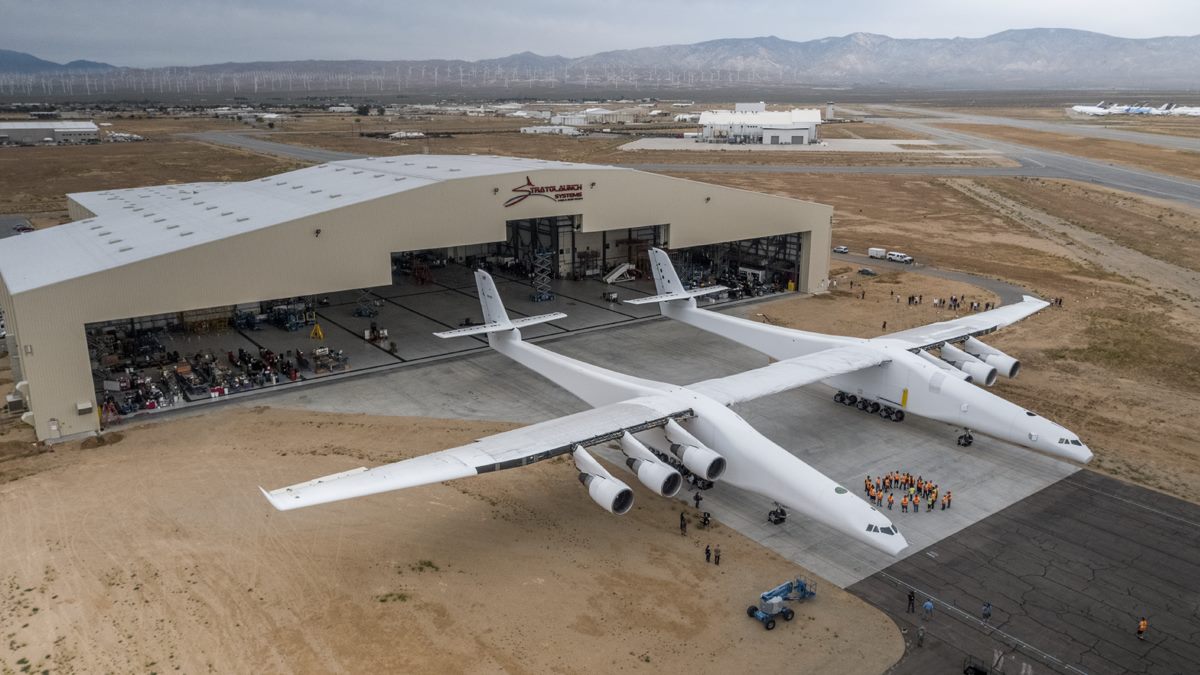The world’s largest aircraft by wingspan left its construction hangar this week in California’s Mojave Desert.
The Stratolaunch is a twin-fuselage aircraft using recycled parts from two Boeing 747-400s that has been designed to lift a rocket (or rockets) weighing up to 227 tonnes and launch it into low Earth orbit.
Microsoft co-founder Paul Allen’s company Vulcan Aerospace is behind the project, which aims to revolutionise the satellite launch industry.
The composite aircraft was nicknamed the Roc during its development, after the mythical giant bird, according to the Seattle Times. It has a wingspan of 117.4 metres (385 feet), twin fuselages 72.5 metres long and twin vertical stabilisers 15 metres high. Its maximum take-off weight of 589 tonnes is slightly less than the world’s heaviest aircraft, the Antonov An225. Its six Pratt and Whitney engines are ex-Boeing 747 units, as are its cockpit windows and flight deck (it will be flown by a three-person crew from the right fuselage; the left fuselage is unpressurised). The aircraft has a relatively short operational range of about 2000 nautical miles, sufficient however to launch up to three rockets in a single flight
The aircraft will now undergo ground testing, engine runs, and taxi tests before its first flight, Stratolaunch chief executive Jean Floyd said. ‘Over the coming weeks and months, we’ll be actively conducting ground and flight-line testing at the Mojave Air and Space Port.’
‘This is a first-of-its-kind aircraft, so we’re going to be diligent throughout testing and continue to prioritise the safety of our pilots, crew and staff,’ Floyd said.
He also confirms the Stratolaunch is on track to perform its first launch demonstration ‘as early as 2019’.
However, since the project was founded in 2011, advances in microelectronics have led to the development of so-called ‘cubesat’ and ‘nanosat’ satellites that are much smaller than previous versions and do not require large rockets to launch them.



I’m certainly not an aeronautical design engineer but ….it just looks….flimsy? Wouldn’t be there enormous forces and flexure operating on the structure joining the two fuselages in both the horizontal and vertical planes? And a twisting moment in the horizontal plane as well? Why not have a strut between the tailplanes, a la De Havilland Vampire? This concept for launching satellites is great, but will watch the Roc’s performance with interest!
I am, Eric, and I share much of your thinking. The torsional rigidity of that inter-fuselage member must be of the highest order, all else being equal. Any severe twisting moment will have one half of the aircraft climbing with the other half diving. OK, that’s stretching it a little but you understand where I head! The controlling electronics will be a tad more upmarket than my MacBook.
I am too John, and in addition to your concerns, landing this thing will be interesting and by not tying both fuselages together means they are totally dependent upon the torsion and bending stiffness of that wing centre section. I’d also be interested to see the results of the ground vibration tests for flutter clearance. Looks to be a high risk configuration to me …
[…] on the anniversary. Its record as the largest aircraft by wingspan stands to be broken by the Stratolaunch, nicknamed the Roc. The Roc, a Frankenstein’s monster mashup of two Boeing 747-400s, has been designed to launch […]
[…] subsequently engaged Scaled Composites as part of his Stratolaunch Systems project. Stratolaunch is a twin-fuselage aircraft using recycled parts from two Boeing […]